
Weeksia coccinea
Smooth Red Scrap
24 September 2023
Jordon River Beach, Juan de Fuca Strait, B.C., Canada
Tide: 1.9 foot low at 4:08 am PDT (measured at Sheringham Point Tidal Station)
Weather: Overcast, wind E 5 to 15 km/hour (windier offshore, 20 to 30 km/hour), low SE swell, sea rippled, humidity 74%, 13˚C.
Moon: Waxing Gibbous (71.8%, 10 days); Next Phase, Full Moon, 29 Sept 2023 at 2:37 am PDT; Previous Phase, First Quarter, 22 Sept 2023 at 12:31 pm PDT.
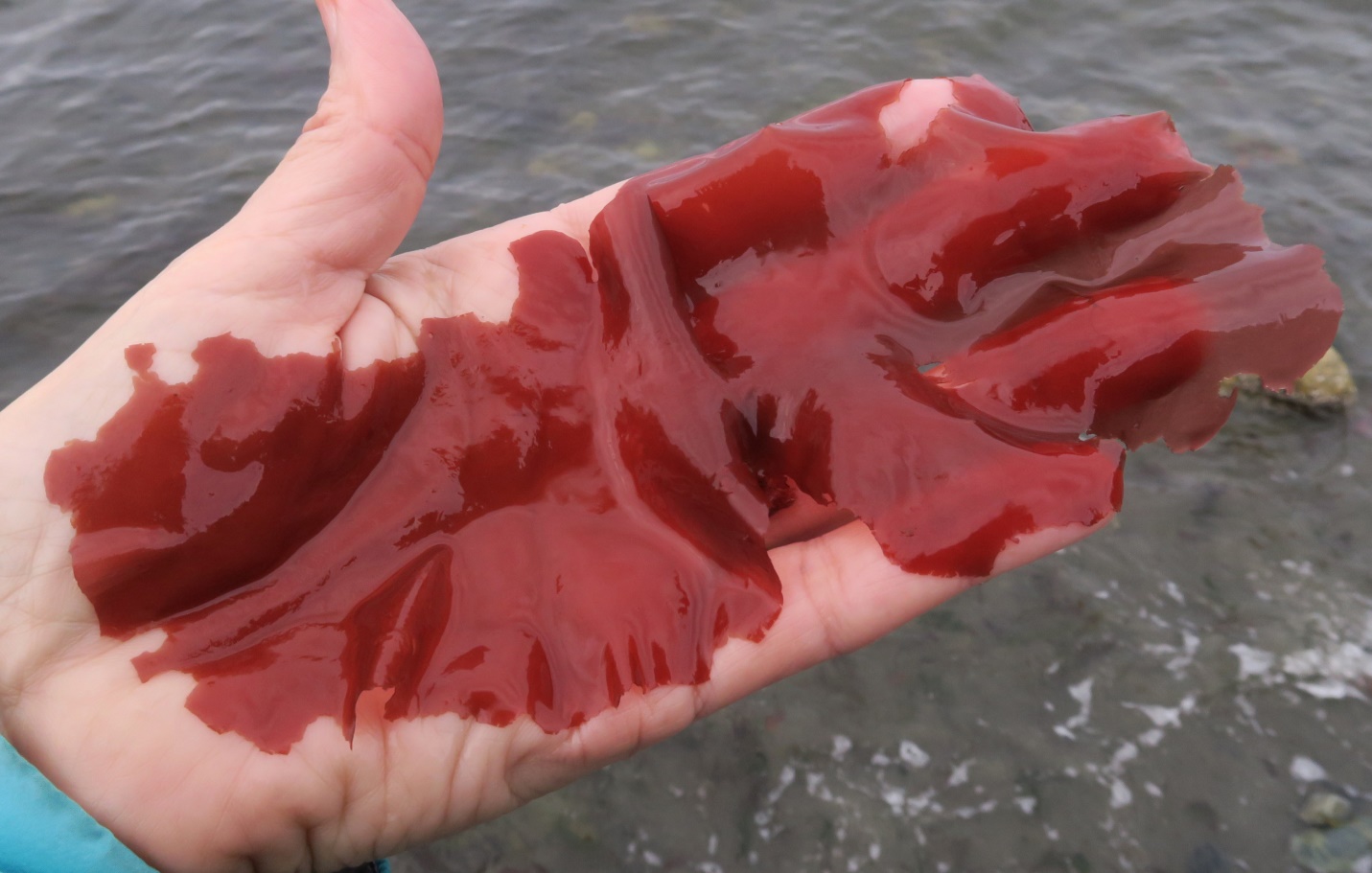
Figure 1: One of the many “scraps of red” algae that we found washed ashore – Weeksia coccinea. Jordon River Beach, Juan de Fuca Strait, B.C., Canada. September 24, 2023. Photo ID 27612 ©Seaweedwhisperings.com
Person 1:
Thin blade, quite simple in appearance.
Definitely smooth and shiny in appearance. To the touch it is also smooth and slippery.
Easily dismissed as small and insignificant.
We found it amongst masses of other washed-ashore seaweeds. Likely found it only because of experience, and now looking for “something different”.
Weeksia coccinea has tiny holdfasts, attached mainly to shells of limpets and tubeworms.
The simple slippery form seems to be a way of passively avoiding interactions with others. It’s not interested in that.
Close up, I sense an internal labyrinth of passageways. Lots of thoughts in many directions?
When spread out for photography, the Weeksia coccinea specimens did not lay flat, instead they displayed attractive gentle folds. Maybe there is a touch of wanting to draw attention, but not overtly.
Hard to stretch apart, but easy to shear / tear.
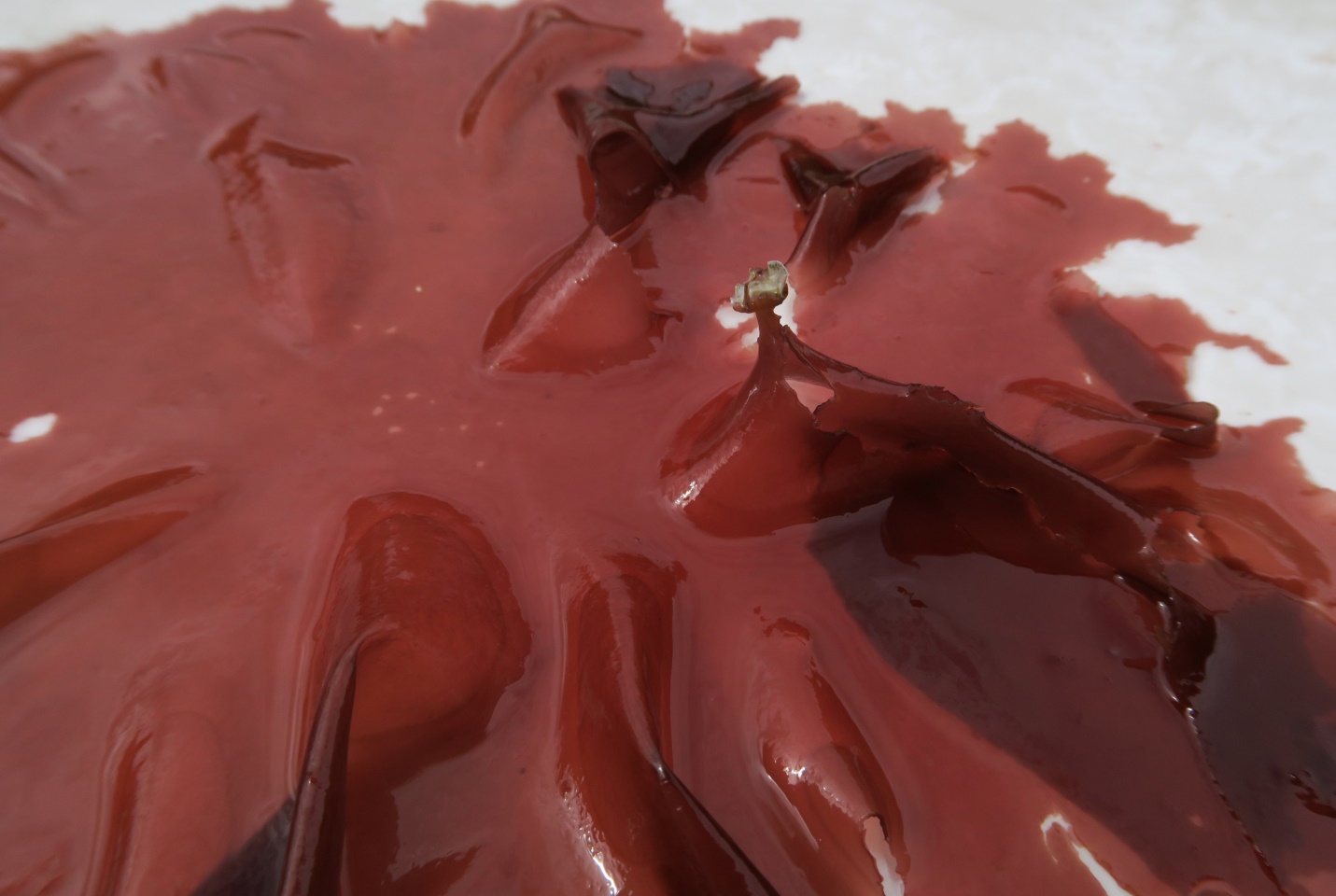
Figure 2: Photographed the next day, this is one of the individuals we found cast ashore. The undulate margins and broad kidney shape of the foliose red blade is apparent. It is ‘posed’ with the holdfast area upright and thus is oriented upside down as compared to its in situ living position. The blade shows no difference, one side to the other, and if it weren’t for the holdfast position its ‘normal’ orientation would be undetectable. It looks as if this Weeksia coccinea was attached to some kind of marine animal’s shell that had broken away. Found at: Jordon River Beach, Juan de Fuca Strait, B.C., Canada. September 24, 2023. Photo ID 27613 ©Seaweedwhisperings.com
Person 2:
This is a red seaweed that I’ve never observed growing in the low intertidal zones, and that is not for want of exploring! I suspect it is truly an occupant of the subtidal regions of our area. This hunch seemed to be supported on this day at the cobble beach near the community of Jordon River, when we found numerous “scraps” of this red alga freshly washed ashore, newly deposited by the previous high tide.
Some of the Weeksia coccinea specimens that we found were entire – so we could see most of the blade largely intact and also how it affixes itself with a very small holdfast. Sometimes there was no evidence of what rock or substrate the seaweed had formerly been attached to. In other cases some of the Weeksia coccinea individuals that we found had been washed ashore because that which they had grown on – small limpets or pieces of tubeworms, had themselves been broken away or dislodged from their native substrate.
In fact the holdfast portion of Weeksia is rather unnoticeable as it is very short and seems to amalgamate itself to or wrap closely around whatever it is growing on.
From the holdfast the single mostly flattened blade grows in the form of a rounded, roughly disc-shaped form.
The blades definitely have a rounded look but can easily become finely tattered at the edges. Or..., is this tattering at the margins evidence of decay occurring in those individuals that we’re seeing today; ones that ALL have been dislodged and washed into more shallow, warmer, brighter waters, and in some cases, even left stranded above the tide line? Possibly so.
Sometimes the broad foliose blade is also torn, with some tears deep enough that they split the blade all the way down to the holdfast.
Because the feel of these blades is definitely slippery it is difficult to imagine what might be able to grab ahold of the blade to cause a tear. But once caught hold of, any tension could easily cause a tear or rip or laceration, because this seaweed is floppy, mid-rib-less and has no outward strength-giving physical structures whatsoever.
I could call Weeksia “delicate” but it has a quality to it that won’t let me go quite that far with the description. Indeed, when I hold a blade in the midst of its span and tug, the seaweed stretches and has quite an elasticity. So, it does have a strength that is not obvious at all upon first assessment.
If, however, I hold the edges of the blade and pull, it tears very readily and in that way is indeed lacking in strength, weak and vulnerable.
The red color of Weeksia coccinea on this day when we found so many, was to my eye, bright and cheery and fresh looking. This gave an overall bright quality to the “little scraps of red alga” that overshadowed any physical imperfections revealed upon closer inspection – such as holes, tears and margins that were overall of a simple contour but up close were very irregularly edged.
In fact the outer margins of the blades are so irregularly shaped that I found it to be quite an interesting “trip” to follow the extreme perimeter of the blade with its countless and varying arrangements of small indentations and projections. It made me think of the outline on a chart or map of a rocky island – where land meets water is a constantly uneven and irregular boundary. It is like there is some kind of unsettledness about where the boundary between these two realms will truly be set, and so there is a back and forth quality to it that is obvious.
For this seaweed then, is it at the edges where its boundaries are highly vulnerable, not firmly established or the most penetrable? And in the main portion, the central mass of the blade, is it quite strong, flexible and secure?
And is there, in general, a whole unsettledness to their energy?
The slippery feel adds another concept to this seaweed’s energy. Slippery..., hard to get a hold of...; also, slips away from being held or pinned down in one place.
Slippery like..., yes, slippery like a fetal sac. This idea came to mind even though I have little experience with the birthing of newborns, but I sense that energy to this whole seaweed – as if it is newborn, fresh, and extremely dependent and vulnerable IF not surrounded by the “right” conditions and care.
There is a highly uniform thickness, or better put, one could say a highly uniform thinness, to the blade of Weeksia. It really is quite perfectly and uniformly constructed in this dimension.
It is also VERY slippery to the touch. Maybe this prevents anything – other algae, diatoms and other marine animals..., from settling on it and blocking the rays of light that penetrate to the “red” regions of the subtidal. So it feels that Weeksia coccinea could actually have little tolerance for, and even become very annoyed or distressed by, any circumstance that would have its perfect slippery surface marred or covered or cluttered by anything else.
Overall Weeksia coccinea has a very simple shape. It seems to just anchor itself well with its uncomplicated holdfast and then immediately expands and expands, outward, into a flat and very flexible and floppy blade. One could say its edges are indeed rounded, but the overall shape is not necessarily truly round at all; it can be a broad oval form, a generous kidney shape or even a rounded rectangle. There seems to be no need for a clear design or shape or form with any notable pattern to it in Weeksia; this is distinctive in that there is nothing much distinctive or predictable to it at all!
In the field I thought of these seaweeds as “little scraps of red alga” and I think that reflects this quality; it is almost as if the shape is somewhat haphazard, unfinished, or unplanned, possibly like a scrap of red fabric that has been torn off from a bolt of cloth but has not yet been cut and sewn into a finished garment to serve a particular function.
It occurred to me also that these little “scraps of red alga” are similar to the “green” alga, Ulva lactuca’s, answer to being very well designed for collecting light in that they are both simply “thin sheets of photosynthesizing cells”. The thickness is just enough to meet the demands of their habitat, and then the breadth, well, that is where it really pays to have some size as this is where the sun’s energy will be collected and converted to chemical energy. This is how the alga will best be able to continue to grow and expand.
Expand..., is that the right word?
Increase in size? Yes.
Become larger? Yes, also.
But not swell, nor elaborate on, or add detail to.
So, indeed, with Weeksia coccinea, it is in this one dimension only that it serves them to grow and expand.
I felt compelled once again to think of the feel of this seaweed; it is so smooth and slippery, really so very soft and slippery in texture. Things that I know of that are like this and that live outside of the ocean environment are usually either very protected and cared for and even polished, or they are very, very new and not yet blemished by the bumps and clashes and day to day challenges of life. One could say this seaweed is as “soft as a baby’s bottom” but the truth is that it is that soft and more – the SLIPPERY description is characteristic.
I came to wonder if there is something about the energy of this seaweed that really has nothing much yet developed, little that is individuated and ready to be truly grasped and identified with it; as if it is simply too new, like the newborns referred to earlier, to reasonably or even possibly embrace such distinctions yet?
This is not to say there is no character to Weeksia, it feels more that no characteristics have yet been truly adopted by it. Weeksia itself lets any such traits slip away, like a child playing “dress-up” with various costumes, they do not hang on to them, at least not for very long.
So what you encounter is an energy that is bright, cheerful, and that can simply and efficiently get the basics of what they need to do done. What you also can find is an energy that is quite self-centered and doesn’t really “play well with others” – Weeksia coccinea doesn’t know yet what to share and what to reserve only for itself.
Difficult or new life conditions can cause it to become quite tattered and torn – truly to resemble much more of a scrap of its former and younger self. I think, too, if it does not have its lovely subtidal consistent water temperature and light conditions, this seaweed can die and then also decay very rapidly. Its grasp on life is adequate, but it also has no real margin for error built in or established yet.
You will do best, when you encounter Weeksia, to nod a greeting, perhaps offer a word or two of encouragement, maybe blow a friendly kiss of simple admiration in its direction, and then to also move right on by..., slipping on out of its way, thereby allowing it to continue to collect all the light it can absorb --- for its own purposes.
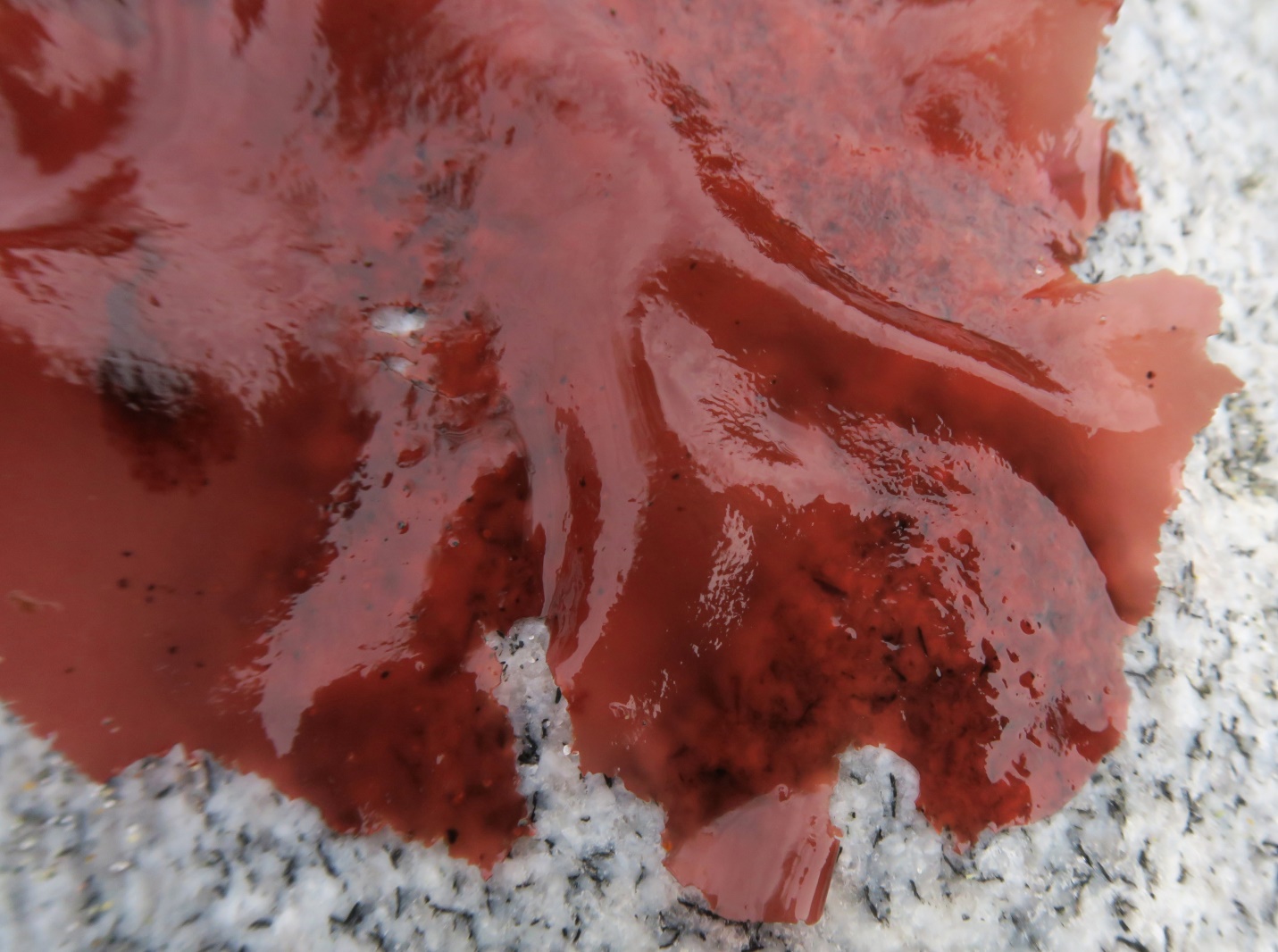
Figure 3: This close up view gives a look at the color and perimeter margins of the blades of Weeksia coccinea. Jordon River Beach, Juan de Fuca Strait, B.C., Canada. September 24, 2023. Photo ID 27614 ©Seaweedwhisperings.com
Discussion:
Smooth and slippery – this gives a way of avoiding interactions, or of only having very brief ones. Weeksia coccinea is not often interested in sustained efforts and interactions or deep discussions, especially if initiated by others.
Undulations on the blade are like “pulses of inspiration” which quickly subside. It’s the situation of having many ideas but not a readiness to commit. If what they’re exploring requires too much effort, they slip away and on to something else. Sticking with something difficult or something that is not capturing their interest in the moment is NOT their best trait. At one point while working on the write up of this Whispering Person 2 exclaimed, “Maybe we should scrap the whole thing!” There is a willingness to abandon and move on to the energy of this seaweed that is notable. Such a trait can be useful, but we’d not experienced it in such abundance, or as such a “go to” mode of being, in any other seaweed we’ve yet encountered.
It’s VERY smooth. One morning during our interactions, Person 1 woke up humming “Smooth Operator”; the sound of the music in this song is very SMOOTH and the question occurred as to whether this seaweed can be impressively smooth and effective because of its smooth and glossy presentation.
Internal labyrinth of passageways..., many directions are possible, none is yet preferred. No direction is felt to be THE way to go. So within themselves, too, they are ‘slipping’ around and basically not committing to anything yet. This has an almost playful feel inherent – like the child playing dress-up, rather than having much to do with abiding by convention or fear of doing wrong.
The gentle folds in the simple blade may indeed draw some attention, but this result feels almost accidental and unplanned. There is a beauty to the undulations and the lovely red color, but Weeksia is basically unaware of this.
This seaweed has notable stretchiness and this seemed like it could probably be a kind of built-in safety mechanism that ensures that in most circumstances, it will bounce back and retreat from harm if conditions or impulses have it ranging out or pulled away from its anchor point too far. Like the simple beauty of the color and the undulate blade margins, this ‘bounce-back’ trait is one Weeksia is also largely unaware of having; it simply “is”.
The tears that can happen, they reflect Weeksia’s occasional manner of reaching out in just the ‘wrong’ way – their efforts are often inexperienced and therefore can prove unwise; wrong choices can often rip it deeply. So if harm comes in this way, it has a sizable impact. There is much to learn yet.
Another way of “reaching out in just the wrong way” was pondered and that involved the situation of being “cast ashore”. We found this seaweed only after it had been cast ashore from its subtidal habitat. So the character of the nearshore waves that carried it out of the ocean depths has significance..., Weeksia could be gently lifted up onto a beautiful sand beach or it could be tossed powerfully and crushed on a rocky headland or pummeled along a surge channel. So the currents and wave action determine exactly what circumstances it might be “cast ashore” into. While for the seaweed this event happens most dramatically when the alga is ultimately about to perish and meet its death, the key qualities of this circumstance feel suitable also to the LIFE of Weeksia coccinea - where they “land” greatly influences their success. And, they don’t determine their “landing spot” for themselves. True, “how they play the hand they’re dealt” is a factor, but their landing point, or where their holdfast chooses to grasp the substrate and support the body of their blade – if this is a favorable place, they can flourish; alternately, a more difficult setting can result in them doing poorly or may even lead to them being torn, falling to pieces and quickly disintegrating.
The word “scrap” stood out with this alga; it fits in that as much as this seaweed can look bright and cheerful, it also has an energy that can be ‘scrappy’ or that one might describe as punctuated with “outbursts of feistiness”. For such a little scrap of red seaweed, one that is rather soft, limp and weak looking, only its color outwardly hints at this trait – that they can be lively and surprisingly competitive and fearless. Again though, this behavior is most commonly sustained in only rather short bursts.
The concept of being “scrapped” can apply for a significant trait in the nature of this seaweed’s energy, too. Being tossed out, thrown away, disposed of, scrapped... indeed, for this red alga it feels as if they themselves can try out many things and scrap them all. Again, no preferences or ways of doing things are yet embraced, so many, many efforts are abandoned. And of course, ultimately, the sea herself tosses these little “scraps of red alga” out of her realm, and they are cast onshore to meet their demise.
The vulnerability at the boundaries, at the perimeter of the lovely red blade, was notable in this seaweed. It represented to us the feel that manifesting as an alga was just newly decided upon, a choice only recently enacted and only barely established. The ‘line’ between “here” and “NOT here” is very near and recent. So there is with this new manifestation a tentative quality and the recognition also that with little provocation, this seaweed could easily reverse their choice and, indeed, quite willingly “scrap the whole idea” and dis-integrate, slipping back on out of physical form once again.
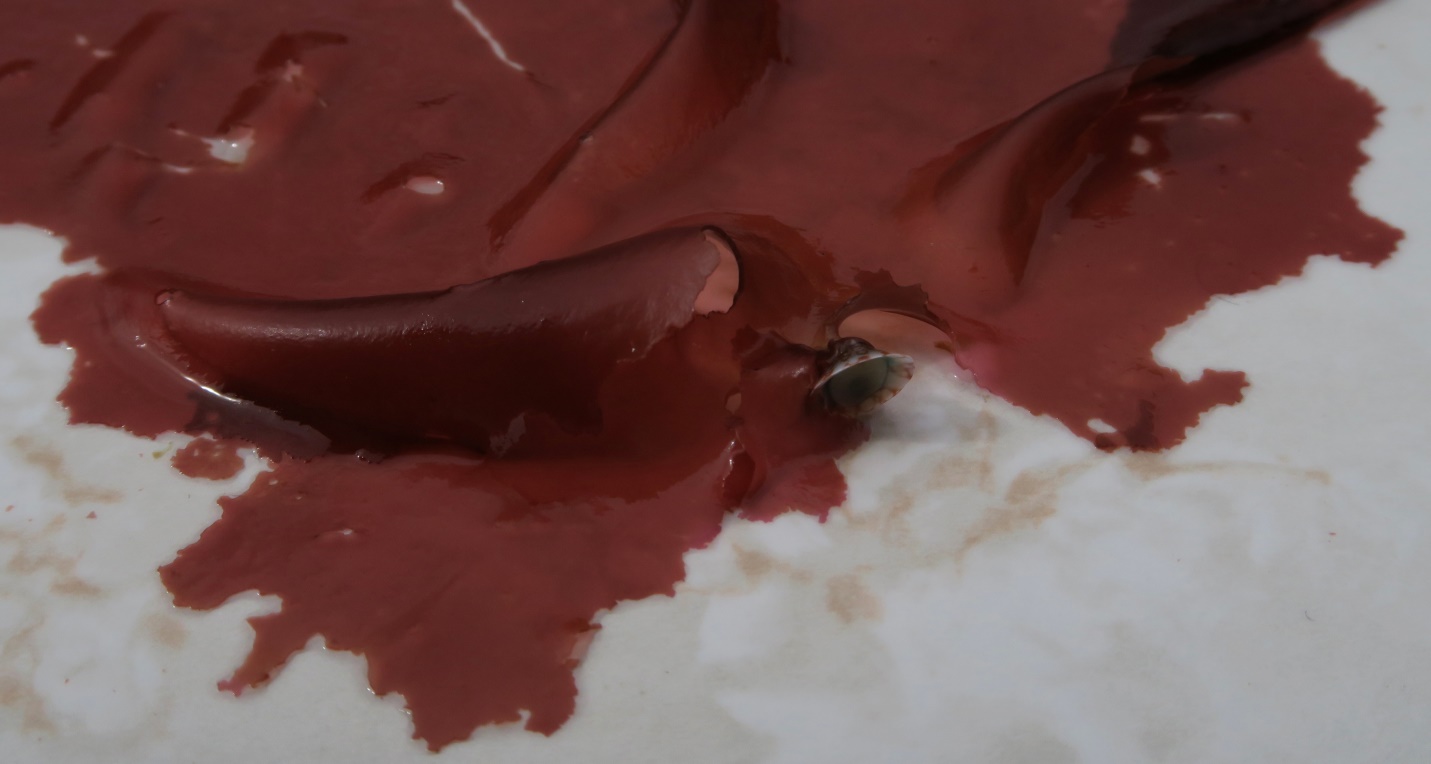
Figure 4: A photo taken one day after collection (with the seaweed retained in a large quantity of cool seawater), shows what we came to understand to be a marked and relatively rapid deterioration. The blade is browner looking and losing its bright red coloration, and the margins are very irregular. If we brushed the margins with a light touch of our fingers they ‘disintegrated’ even further with the tiniest of pieces of red alga all simply crumbling away, but the main part of the blade still had resilient elasticity. This “Smooth Red Scrap” alga was anchored to a tiny limpet shell, but they often grow on subtidal rock, too. Found at: Jordon River Beach, Juan de Fuca Strait, B.C., Canada. September 24, 2023. Photo ID 27615 ©Seaweedwhisperings.com
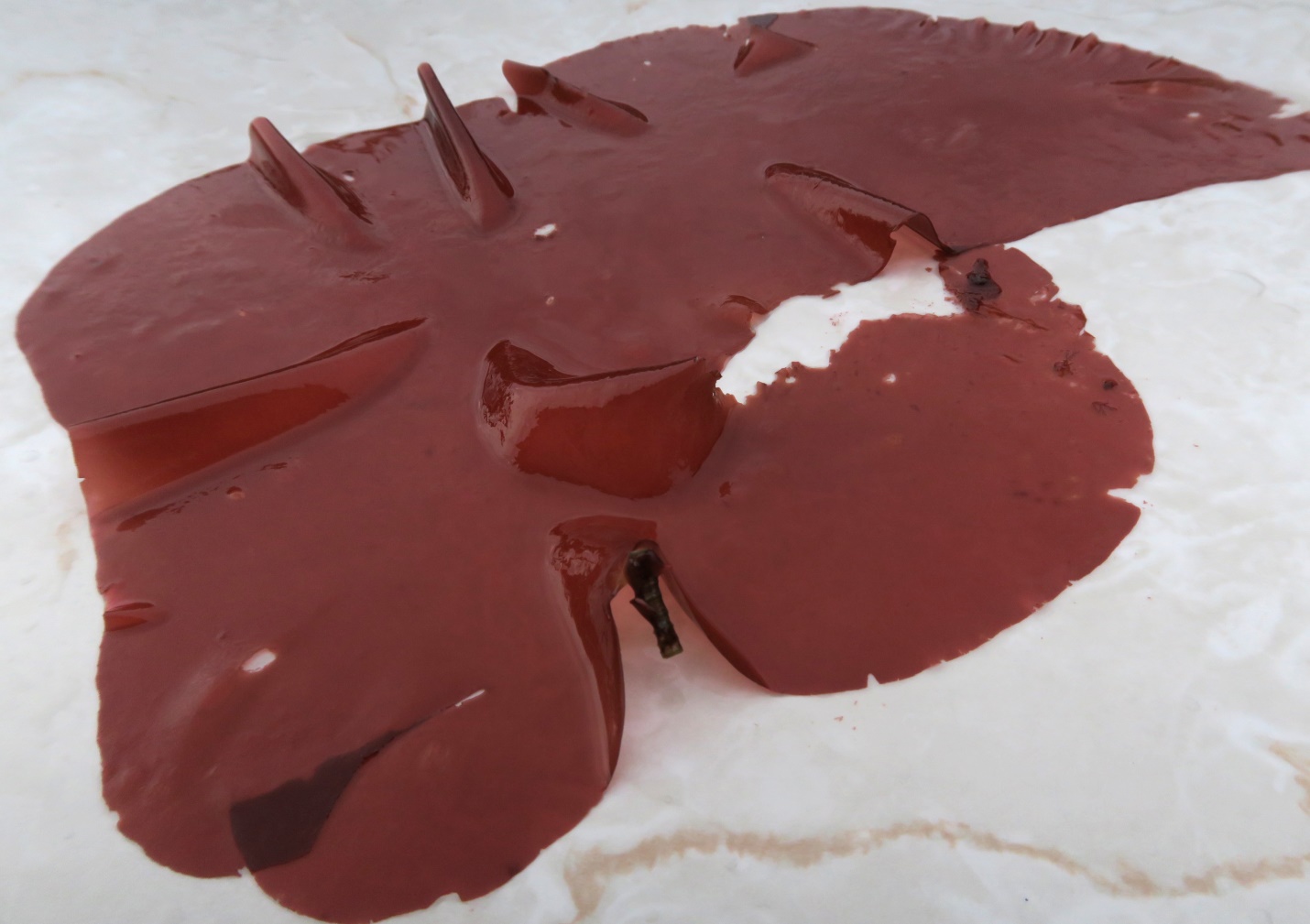
Figure 5: Another specimen, again one full day after collection from the shoreline, shows the gentle undulate margins, a large tear and a portion of tubeworm that was the anchor point for its holdfast. Found at: Jordon River Beach, Juan de Fuca Strait, B.C., Canada. September 24, 2023. Photo ID 27616 ©Seaweedwhisperings.com
Biology & Natural History Information:
Description:
Foliose thallus grows on rock, rarely epiphytic, usually solitary; overall shape includes lanceolate and broadly lanceolate (with cuneate or subcordate bases), orbiculate (circular or rounded) to reniform (kidney shaped). Blades are cleft or un-cleft, with or without conspicuous veins radiating from the base, unbranched initially and can become multiaxial with maturity. Size ranges include 15 – 40 cm wide, 30 – 45 (110) cm long. Color is a bright red; descriptions range from cherry red, carmine, scarlet and crimson; the blade has a soft and slippery texture. Base of thallus originates from a short broad stipe and a discoid holdfast. Blade margins are ruffled, undulate, or plane. Blade 300 – 500 µm thick.
Habitat:
Locally common on rock, subtidal, depths of 8 to 35 meters. Frequently cast ashore throughout its range.
North Pacific Distribution:
From Amchitka Island, Aleutian Islands, Alaska on through the coastline of Alaska and British Columbia south to Monterey, California.
Remarks:
When fresh, the color of this species helps to distinguish it from other foliose red algae along with its very slippery texture. Nomenclature and taxonomic review resulted in this species, formerly known as Halymenia coccinea, being moved from the genus Halymenia to that of Weeksia; the author describes Weeksia coccinea’s color as being Dragon’s blood red to Vinaceous tawny and as such, reminiscent of Weeksia fryeana. So the current name brings the coccinea species name to the genus Weeksia. “Coccinea” is from the Latin meaning deep red.
Classification:
Phylum: Rhodophyta
Class: Florideophyceae
Order: Gigartinales
Family: Dumontiaceae
Genus: Weeksia
Species: Weeksia coccinea (Harvey) S.C.Lindstrom 1986
Former name(s): Homotypic synonyms; Schizymenia coccinea Harvey 1862 and Halymenia coccinea (Harvey) I.A.Abbot 1967. Heterotypic synonym, Weeksia freyeana Setchell 1912.
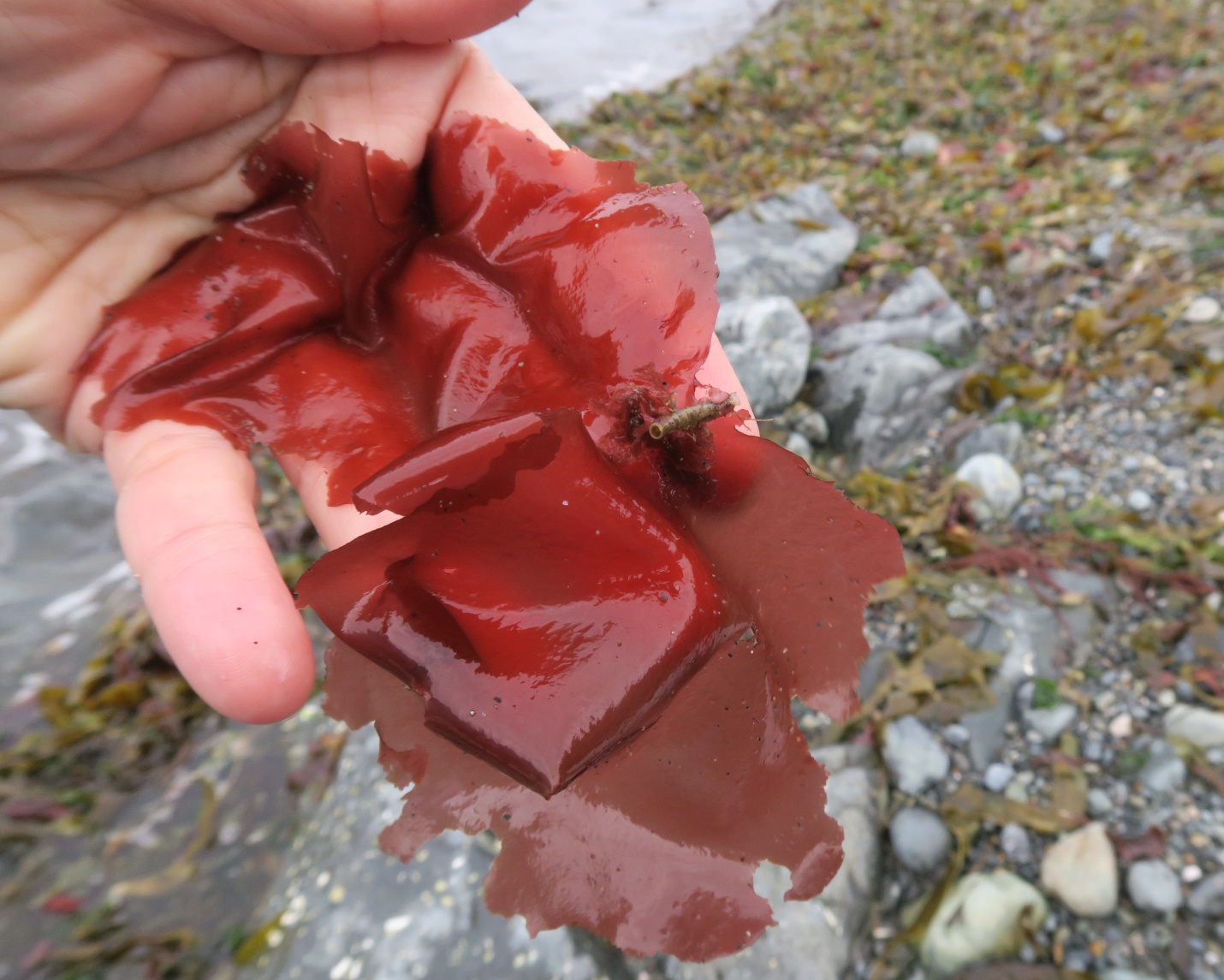
Figure 6: This particular individual had grown from a segment of a tube worm (and actually another very small, less than 1cm tall, finely branched species of red algae chose the same tubeworm as its home base). This ‘landing spot’ from which Weeksia coccinea grew may have felt nearly as secure as growing from a rock, until the tube worm was broken and the whole collection of marine life was ‘cast ashore’. Jordon River Beach, Juan de Fuca Strait, B.C., Canada. September 24, 2023. Photo ID 27617 ©Seaweedwhisperings.com
![]()